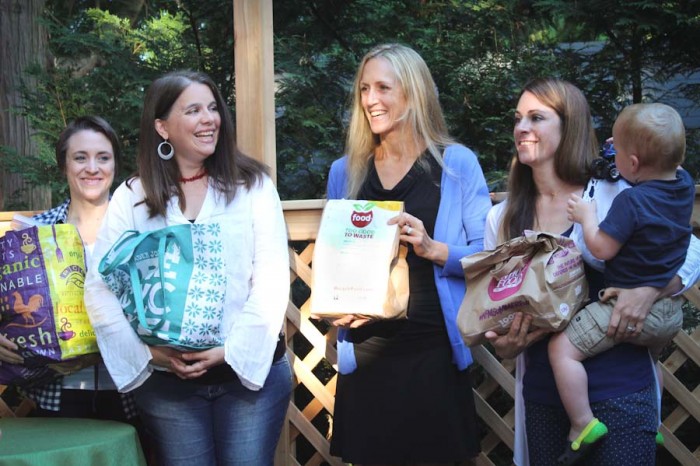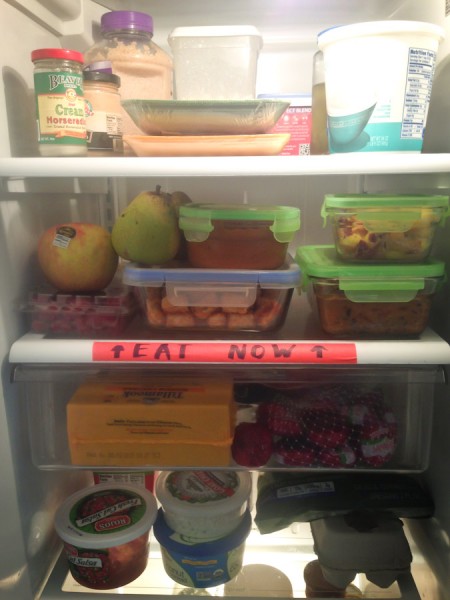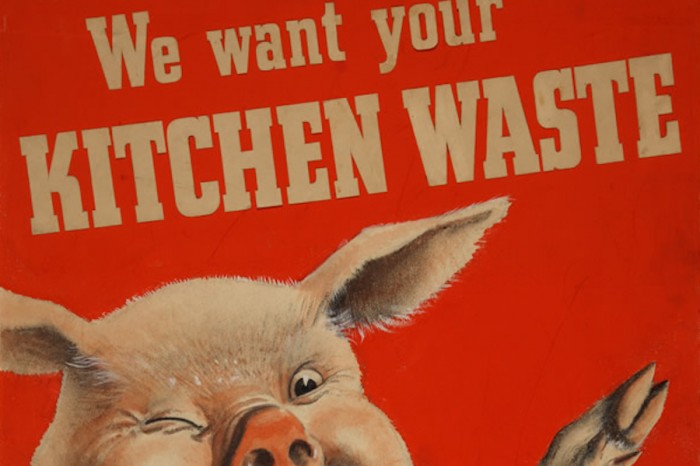Kirkland resident Gina VanLoon hardly has any food waste in her compost bin.
But that isn’t something she could brag about a few months ago. VanLoon knew she had a problem with too much produce rotting before someone in her family of five could eat it.
But she didn’t really know what to do.
The problem stemmed from a change to a whole foods diet after her daughter was diagnosed with allergies, she said. She started buying more fresh fruits and veggies, in particular organic ones.
“I’m buying pears that are $3.99 a pound and throwing half of them away,” she said.
Then she heard from a friend that King County was recruiting households to try a food waste audit and thought it might help her to figure out how to stop wasting food.
Read part 1: Why we’re wasting food in a hungry world
Household waste is the “biggest slice” of the food waste pie, said Ashley Zanolli, an environmental engineer at the Environmental Protection Agency’s (EPA) regional office in Seattle who led the design of the Food Too Good to Waste tool kit to measure food waste in homes. Piloted by the West Coast Climate and Materials Management Forum, the program is being used in communities in seven of the EPA’s 10 regions. Both the city of Seattle and King County have recruited participants for the audits.
The solution is just one way to tackle global food waste in a complex food system. According to a Natural Resources Defense Council report, the U.S. throws away approximately 40 percent of its food supply, wasting energy, water, land and chemicals used for fertilizers and pesticides.

Jina Kim, a solid waste program specialist for the City of Renton, also recently took part in the audit. She said she was aware that her family was wasting food, contributing to a national problem, but didn’t realize how much.
“Many of us take food for granted. But there are people in this world and country who can’t afford or simply do not have access to delicious and nutritious foods,” she said. “Food waste… not only takes away valuable and finite resources that could be better used elsewhere, but also contributes to climate change as food waste in landfills produce greenhouse gases.”
The first week in the program, participants saved all of their waste in a baggie in the freezer.
“I knew I was wasting the veggies. What I did not realize that I was wasting is the takeout and the leftovers, so that was the educational piece for me,” said VanLoon. “I expected to see two apples, a pear, an avocado and a banana… but also a pork chop, chicken teriyaki, pizza, and four slices of bread?”
With food prices higher than ever, throwing away spoiled food can feel like tossing cash in the trash — but it turns out that saving money isn’t the biggest motivator.
“We found that ‘waste aversion,’ or the psychological reaction people have to the loss of utility of something, was a stronger motivator for people to waste less food than the cost savings or potential health benefits,” explained Zanolli.
VanLoon implemented some suggestions from the kit the second week and measured her waste again. This continued for a month, and over time she was able to consciously change her habits. According to Zanolli, strategies implemented by pilot participants have reduced waste by an average 25 percent, which is almost $150 per month in grocery savings.
While consumer waste toolkits aim to educate individuals at the household level, some activists are putting pressure on grocery stores and businesses further up the food supply chain to change practices in order to reduce food waste.
Dana Gunders, staff scientist at the Natural Resources Defense Council in San Francisco, suggests that standardization and clarification of food expiration dates, which can cause consumers to throw away perfectly good food, would help. A UK study estimated that 20 percent of home food waste is due to confusion over expiration dates. This has already led to a revision of standards by the UK government to limit labels to food safety rather than food quality.
It’s standard for grocery stores in the U.S. to pull items off the shelf at least two days before their sell-by date. Most of the time this food is perfectly safe to eat. The designations “sell-by” “use-by” and “best-before” can just be a suggestion of when the food is at peak quality but aren’t meant to indicate food safety.
Activists in Europe are also trying to change perceptions about wonky looking vegetables. Feeding the 5000 runs a global campaign that addresses grocery store cosmetic standards, while Portugal’s Fruta Feia also began highlighting the impact of food waste felt by small local farmers who focus on cultural varieties of produce not up to European Union standards.
Catching on this summer, perhaps the most market-savvy effort to bring attention to the issue is the French supermarket chain Intermarché’s viral Inglorious Fruits and Vegetables campaign starring produce that wouldn’t make it in Hollywood. They sold the produce at a 30 percent discount and sold an average 1.2 tons per store in the first two days, facing the problem of running out.
Dena Hastings, Pacific Northwest regional Green Mission specialist at Whole Foods, explained that there are also other ways grocers can reclaim waste. The supermarket chain donates to food banks, but internally, the bakery or the prepared food department pulls items that are considered unsellable for cosmetic reasons — but are still safe to eat — to use as ingredients in their ready-to-eat products.
Compost is another option if food is no longer safe to eat, said Hastings. Bellevue’s Whole Foods store is currently testing out a new on-site commercial biodigester that will reduce the number of pickups needed for a traditional compost bin. The machine even has a computer program that keeps track of what items are being put into the compost, which Hastings said will hopefully help to refine buying practices and help the store from purchasing too much in the first place.
That’s currently a big problem for grocery stories. If you think it’s hard to gauge how much produce to buy for your family, imagine making those same calculations on a massive scale to stock a grocery store and trying to anticipate the choices of thousands of consumers.

VanLoon agreed that grocery stores like Whole Foods should take a leading role in tackling food waste, but in the end, she says, the biggest impact citizens can have is by changing their own habits.
“We’re a foodie area, and most of us who are foodies run out and buy everything on the recipe,” she pointed out. But then you end up with an odd ingredient in your cupboard that you’ll never use again.
Instead, people can be taught how to “shop their pantry” and find acceptable substitutes, such as lemon juice for lime juice, for example. Retailers or other community centers can lead this effort by providing cooking classes geared to addressing food waste, she suggested.
As a result of participating in the food waste audit, VanLoon now has some of her own tips: Since the audit, she has designated one shelf in her refrigerator as an “Eat now” shelf, which helps let her family know which produce will go bad if not eaten. Leftovers can also go on that shelf, though VanLoon has become more creative about what to do with leftovers, incorporating them into other meals throughout the week instead of expecting everyone to eat them the next day for lunch.
She also started throwing fruit on the cusp of overripe into the freezer and making mixed fruit crumbles once she has enough. This has resulted in some new flavor combinations, including blueberry pineapple pear crumble.
Following the audit, Kim emphasized how changing consumer habits can have big impact on retailers:
“By purchasing only the items that we will use, we help stores stock only those items that they can sell and the effect trickles down all the way down to farmers and producers of items that make the food industry go around, leading to wasting less resources and reducing our carbon footprint,” she said “Can you imagine the impact we can have if every household can reduce their food waste by half or even a third?”
Read part 1: Why we’re wasting food in a hungry world



The large amount of fresh food waste is a lose-lose situation for the environment, the struggling families in today’s tough economy and for the food retailers. There is no single cure, or silver bullet for food waste reduction therefore, we should address the food waste problem in every link in our food supply chain. For example, the excess inventory of fresh perishables close to their expiration on supermarket shelves, combined with the consumer “Last In First Out” shopping behavior, might be the weakest link of the fresh food supply chain.
The new open GS1 DataBar standard enables applications that encourage efficient consumer shopping by offering him automatic and dynamic purchasing incentives for fresh perishables approaching their expiration dates before they end up in a landfill.
The “End Grocery Waste” App, which is based on the open GS1 DataBar standard, encourages efficient consumer shopping behavior that maximizes grocery retailer revenue, makes fresh food affordable for all families and effectively reduces the global carbon footprint.
k-12 FoodRescue
https://www.youtube.com/watch?v=Oiuapkrky_w
a very important series…excellent and informative like all of your features.
Great ideas and stunning to think nearly half of our food gets wasted!
It might also help to downsize refrigerators, grocery bags and packaging. Cotton produce bags really cut down on lettuce and greens going bad in plastic (!) produce bags. Since we started not over-buying food (bulk bins = buy exactly how much you need), our fridge is often half-empty. A smaller fridge can even save on electricity bills!